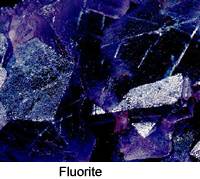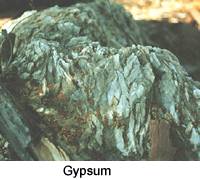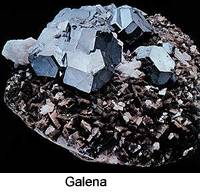BACKGROUND:
A mineral is "a naturally occurring, inorganic
element or compound with a definite chemical composition, a characteristic
crystalline structure, and distinct chemical properties". Minerals have
to be naturally created or else they are classified as man-made substances.
Minerals are the building blocks of rocks.
Most minerals have key characteristics that help in
their identification. Halite (table salt), which is composed of sodium
(element #11) and chlorine (element #17) is a good example. The key
characteristics of halite are its cubic crystal shape, lack of color (it is
clear) and salty taste. Knowing these characteristics helps identify halite.
PROCEDURE:
In the lab, the students will work at stations to
begin to distinguish the key characteristics of minerals. These include
color, hardness, density, crystal shape, texture and cleavage.
- Prior to lab, cut the "Mineral Cards" for
each station listing the questions that you want the students to answer.
Place the cards in front of the minerals. If the card asks the students
to perform a test, such as scratching the mineral with a nail, make sure
that the correct materials are available.
- Using the Periodic Table Placemats, review the
composition of each of the minerals in the lab. You can use the cards
that accompany the specimens as a guide to composition. Direct the
students to locate the elements on the periodic table as you tell them
the "ingredients."
- After students have completed the lab, discuss the
specific key characteristics of each mineral. Use the information below
as a guide.
QUARTZ is a naturally
clear mineral. It can occur in almost any color, however, if it contains
traces of other elements. Its natural crystal shape is 6 sided. Quartz is
very hard (7 on Mohs hardness scale). It cannot be scratched by a steel
knife or nail. Quartz is the most common mineral on the surface of the
Earth. It is found in nearly every geological environment and is a component
of almost every rock type. Quartz is used to make glass, electrical
components, optical lenses, and abrasives. It is also used as a gemstone,
ornamental stone, and building material.
 FLUORITE
breaks into 8 sided polygons (dipyramidal shapes). It has a hardness of 4 on
the Mohs scale. Fluorite is prized for its glassy luster and rich variety of
colors, including purple, blue, green, yellow, colorless, brown, pink, black
and reddish orange. Most fluorite from the United States is clear to purple
in color. The word fluorite comes from its use as a flux in steel and
aluminum processing. Fluorite is also used as a source of fluorine for
hydrofluoric acid and fluorinated water.
FLUORITE
breaks into 8 sided polygons (dipyramidal shapes). It has a hardness of 4 on
the Mohs scale. Fluorite is prized for its glassy luster and rich variety of
colors, including purple, blue, green, yellow, colorless, brown, pink, black
and reddish orange. Most fluorite from the United States is clear to purple
in color. The word fluorite comes from its use as a flux in steel and
aluminum processing. Fluorite is also used as a source of fluorine for
hydrofluoric acid and fluorinated water.
PYRITE shows cubic crystal forms. It has a
metallic luster, and a distinctive brassy-to gold color. Since it is
composed partially of iron, is very dense. Because of its color, pyrite is
the classic "fool's gold." Pyrite has been mined for its sulfur
content for use in defense and chemical industries.
 GYPSUM
crystals are tabular in shape. Gypsum ranges from white to pink in color. It
is very soft, and can be scratched by a fingernail. Gypsum is one of the
more common minerals in sedimentary environments. It often forms in desert
areas where evaporation rates are high, by precipitation from highly saline
water. Gypsum’s uses include plaster, wall board, cement, fertilizer,
paint filler, and ornamental stone.
GYPSUM
crystals are tabular in shape. Gypsum ranges from white to pink in color. It
is very soft, and can be scratched by a fingernail. Gypsum is one of the
more common minerals in sedimentary environments. It often forms in desert
areas where evaporation rates are high, by precipitation from highly saline
water. Gypsum’s uses include plaster, wall board, cement, fertilizer,
paint filler, and ornamental stone.
CALCITE forms the rhombohedral and hexagonal
prism shapes. It occurs in light shades of white, yellow, orange, blue,
pink, red, brown, green, black, and gray. It may also be colorless. Calcite
fizzes readily with HCl. It is soft (about 3 on the hardness scale) and is
easily scratched with a knife. Calcite may be clear to yellow in color. When
a clear calcite crystal is placed over an image or word, it appears doubled
when viewed through the crystal. This is called double refraction.
MICA crystals occur in very thin sheets. This
is an excellent example of a mineral with one cleavage; the sheets form
along a plane of weak atomic structure in the mica crystals. Mica is used as
a heat insulator. There are two common types of mica: a) biotite(black to
brown color) and b) muscovite (clear, white, or silver in color). Mica is a
common rock forming mineral; it is present in most igneous and metamorphic
rocks.
 GALENA
forms cubic crystals with a characteristic stepped pattern caused by
complexities in the mineral’s crystal structure. Galena has a metallic
luster, and is gray to silver in color. It contains large amounts of the
element lead, so it is very dense. Galena is commonly mined and processed
for lead, however, some galena crystals contain up to 1% silver. Galena is
thus also an important source of silver.
GALENA
forms cubic crystals with a characteristic stepped pattern caused by
complexities in the mineral’s crystal structure. Galena has a metallic
luster, and is gray to silver in color. It contains large amounts of the
element lead, so it is very dense. Galena is commonly mined and processed
for lead, however, some galena crystals contain up to 1% silver. Galena is
thus also an important source of silver.
FELDSPAR has a complex, roughly rhombohedral
crystal shape. There are many types of feldspars including plagioclase
(white) and orthoclase (pink-orange). Although opaque, feldspar crystals
have a glassy luster. Quartz and steel will scratch feldspar. Feldspar is a
common mineral in igneous and metamorphic rocks. Feldspars are used in
making ceramics, as a building material, and as gemstones (the variety
moonstone).
ULEXITE grows in fibrous crystals. This gives
the mineral a special property; for complex optical reasons, images can
travel along the fibrous crystals with little distortion. For this reason,
ulexite is often called "TV rock," although it is a mineral.
Ulexite is white, and a source of the element boron. Ulexite precipitates
from lakes in arid regions due to evaporation. The lakes form only during
rainy seasons due to runoff from nearby mountains. Ulexite is used to make
some detergents, especially for washing clothes
HEMATITE crystals tend to be very small. This
mineral is metallic; it may either appear as a shiny steel color or a dull
red. When scratched on porcelain, hematite shows a red-brown streak.
Hematite gets its name because of this color, from a Greek word meaning
"blood_like." Ancient superstition held that large deposits of
hematite formed from the blood that flowed into the ground after large
battles. It contains large amounts of iron, so hematite is quite dense.
Hematite is an important ore of iron and its red color lends itself well for
use as a pigment.